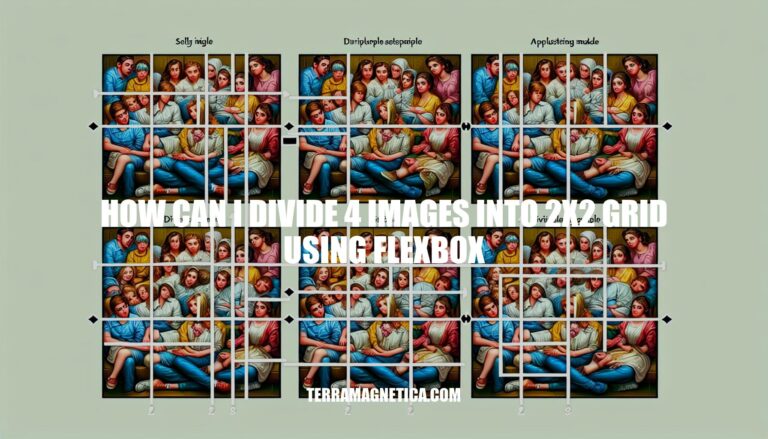


Welcome to the world of web design where creating visually appealing layouts is key to engaging your audience. Have you ever wondered how you could divide 4 images into a neat 2×2 grid using flexbox? In this guide, we will explore the art of using flexbox to craft aesthetically pleasing grids that showcase your images brilliantly.
Let’s dive in and unlock the secrets to mastering this technique!
To create a 2×2 grid of images using Flexbox, follow these steps:
HTML Structure:
or a
).
element.CSS Styling:
.gallery {
display: flex;
flex-flow: row wrap; /* Arrange items in rows and wrap to the next line */
list-style: none; /* Remove bullet points from the list */
margin: 32px 0; /* Add some spacing around the container */
}
):
.gallery li {
margin: 0 10px; /* Add spacing between images */
flex-basis: calc(50% - 20px); /* Set the width of each item (50% minus margins) */
}
.gallery img {
width: 100%; /* Occupy 100% width of the list item container */
height: auto; /* Maintain aspect ratio */
}
HTML Example:




Remember that when you create a flex container (by applying display: flex or display: inline-flex), the child elements become flex items. In your case, the
is the flex container, and the
elements are the flex items. Applying flex properties to the
elements ensures they sit side by side in a 2×2 grid.
Let’s create a basic flexbox grid layout in HTML. Flexbox is a powerful CSS layout model that allows you to create flexible and responsive designs without relying on floats or positioning. Here’s a simple example of how you can structure your HTML for a flexbox grid:
1
2
3
4
In the above code:
serves as the flex container.
represents a flex item within the container.Feel free to adjust the styling, add more items, or customize the layout according to your specific requirements!
You can create a 2×2 grid layout using flexbox properties. Here’s an example of how to achieve this:
A1
B1
A2
B2
In this example:
.flex-grid is the container for the grid..grid-item represents each cell.For more information on flexbox, you can refer to the CSS-Tricks guide.
Creating a responsive image gallery using CSS flexbox is a great way to showcase a collection of images in a grid-like layout. Let’s dive into the steps for achieving this:
Flexbox is a powerful CSS layout module that allows you to create flexible and dynamic layouts in one dimension (either rows or columns). It provides properties to align and justify flex items inside flex containers. Additionally, flexbox can wrap items onto multiple lines, which is perfect for creating grid-like structures.
Let’s start with a simple layout for our image gallery. We’ll assume that each image has uniform dimensions. Here’s how you can structure your HTML and apply flexbox:
HTML Structure:


CSS (Flexbox):
.gallery {
display: flex;
flex-wrap: wrap;
justify-content: space-between;
}
.gallery img {
width: 100%; /* Ensure images fill the available space */
height: auto; /* Maintain aspect ratio */
}
In the above code:
.gallery container to display: flex to enable flexbox behavior.flex-wrap: wrap ensures that images wrap onto the next line when there’s not enough space.justify-content: space-between evenly distributes the images horizontally, leaving equal spacing between them.To customize the layout further, you can adjust properties like margins, padding, and overlay effects. For example, you can add a hover effect to display an overlay when users interact with an image.
Remember that flexbox automatically handles the alignment and spacing, making it responsive without the need for media queries. However, if you want to fine-tune the design for specific breakpoints, you can use media queries.
To maintain image aspect ratios, set height: auto on the images. This ensures that they scale proportionally when the container size changes.
For more detailed examples and additional tips, check out this LogRocket tutorial.
Optimizing your Flexbox grid for responsiveness is crucial to ensure your web layouts adapt seamlessly across various devices. Let’s dive into some practical tips:
Understand the Basics:
flex-direction: Defines the main axis direction (row or column).flex-wrap: Controls wrapping of items.justify-content: Aligns items along the main axis.align-items: Aligns items along the cross axis.flex: Shorthand for growth, shrinkage, and basis.CSS Grid Essentials:
grid-template-columns and grid-template-rows: Define columns and rows.grid-column and grid-row: Position items on the grid.grid-gap: Set spacing between grid cells.Responsive Layouts:
fr, %, vw, vh) over fixed ones (like px).flex-direction: Switch between row and column layouts at breakpoints.flex-wrap: nowrap on desktop, allow wrapping on smaller screens.flex-grow, flex-shrink, and flex-basis for proper sizing.display: none with media queries to hide tertiary items.order property based on screen size.In conclusion, mastering the art of creating a 2×2 grid layout using flexbox opens up a world of design possibilities for showcasing images on your website. By following the steps outlined in this guide, you can easily arrange your images in a visually appealing grid that enhances user experience. Remember, flexbox offers a powerful way to design responsive layouts without the need for complex CSS techniques.
So, go ahead, experiment with different styles, and elevate your web design game with flexbox grids. Happy designing!